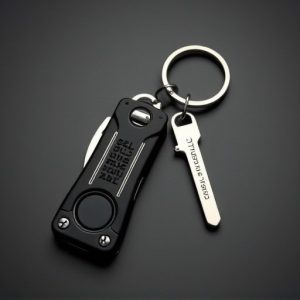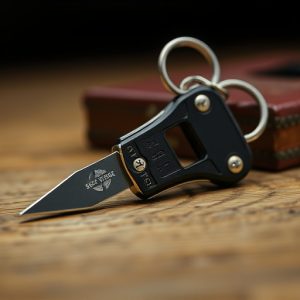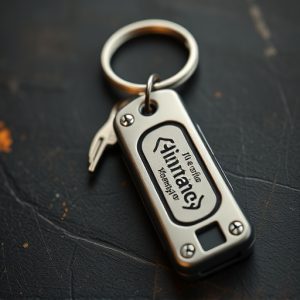Legal Self Defense Keychain Regulations: Functionality, Rights, and Navigating Rules
Defensive keychains with panic alert systems offer personal safety tools governed by varying Legal S…….
Defensive keychains with panic alert systems offer personal safety tools governed by varying Legal Self Defense Keychain Regulations worldwide. Understanding local laws is crucial to ensure these devices operate within legal boundaries and maximize effectiveness in dangerous situations, such as schools or public gatherings. Compliance includes adhering to age restrictions, product safety guidelines, and proper activation protocols to avoid legal issues and empower users with peace of mind.
“In today’s uncertain world, self-defense tools have evolved beyond traditional methods. The defensive keychain with a panic alert system offers a compact yet powerful solution for personal safety. This comprehensive guide explores the legal intricacies surrounding Legal Self Defense Keychain Regulations, delving into the functionality and benefits of these innovative devices. We’ll navigate the complexities, ensuring you’re informed about your rights and the practical considerations when equipping yourself for emergency situations.”
- Understanding Defensive Keychains: A Legal Perspective
- The Functionality of Panic Alert Systems
- Regulatory Considerations and Self-Defense Rights
- Navigating Legal Self-Defense Keychain Regulations
Understanding Defensive Keychains: A Legal Perspective
Defensive keychains, equipped with panic alert systems, have become a popular tool for personal safety. From a legal perspective, these devices fall under regulations governing self-defense and emergency alerts. The specific laws vary by jurisdiction, but generally, they are intended to empower individuals to protect themselves in potentially dangerous situations.
In many regions, the use of such keychains is legal as long as the panic alert feature operates within certain guidelines. These include ensuring the activation of the alarm is intentional and not triggered inadvertently. Additionally, there may be restrictions on when and where these devices can be used, especially in public spaces, to prevent false alarms that could disrupt or alarm others. Understanding local Legal Self-Defense Keychain Regulations is crucial for responsible usage and avoiding potential legal consequences.
The Functionality of Panic Alert Systems
Panic alert systems on defensive keychains are designed to provide users with a quick and discreet means of alerting others—and even emergency services—in case of distress or an unexpected situation. These compact devices often incorporate advanced technology, such as GPS tracking and loud alarms, enabling them to function both as self-defense tools and personal safety networks. When activated, the alarm can deter potential threats and notify nearby bystanders or pre-registered contacts about a user’s location, ensuring swift assistance in case of an emergency.
In many regions, legal regulations around self-defense keychains carry significant implications for their functionality and accessibility. Legal Self Defense Keychain Regulations vary from place to place, dictating which features are permissible, the level of protection offered, and who can obtain them. Understanding these regulations is crucial to ensure that such devices comply with local laws while providing users with the necessary peace of mind in potentially dangerous situations.
Regulatory Considerations and Self-Defense Rights
The development and distribution of a defensive keychain with a panic alert system, while offering enhanced personal safety features, must navigate a complex landscape of legal and regulatory considerations. In many jurisdictions, self-defense products are subject to strict regulations designed to ensure their safe and responsible use. These regulations often encompass product safety standards, age restrictions for usage or purchase, and guidelines on when and how the panic alert feature can be activated. Compliance with local Legal Self Defense Keychain Regulations is paramount to protect consumers and maintain public safety.
Understanding one’s Self-Defense Rights under these regulations is crucial. This includes recognizing legal limitations on using such devices as a weapon and being aware of the circumstances under which a panic alert signal can legally be deployed in public spaces. Navigating these Legal Self Defense Keychain Regulations requires careful consideration to ensure that personal safety tools are both effective for deterrence and compliant with local laws, thereby empowering individuals while avoiding potential legal repercussions.
Navigating Legal Self-Defense Keychain Regulations
Navigating Legal Self-Defense Keychain Regulations is a crucial step in ensuring that your defensive keychain with panic alert system operates within the confines of the law. Different regions have distinct laws regarding self-defense devices, including keychains with panic alerts. It’s essential to understand these regulations to avoid legal complications and ensure your personal safety.
In many jurisdictions, carrying a self-defense device is permitted, but specific conditions apply. These may include age restrictions, registration requirements, and places where such devices are prohibited, like schools or public gatherings. Staying informed about local laws can help users employ their defensive keychain effectively while adhering to legal boundaries.
In conclusion, defensive keychains equipped with panic alert systems offer a powerful tool for personal safety, especially in light of the growing importance of self-defense rights and changing legal perspectives. However, navigating the complex landscape of Legal Self Defense Keychain Regulations is crucial to ensure these devices remain effective and legally sound. Understanding both the functionality and limitations of these tools, along with the regulatory framework surrounding them, is essential for users to make informed decisions while prioritizing their safety.


